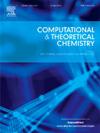Dual cations sensing mechanism of a Al3+/Zn2+ sensor: Roles of ESIPT and TICT
IF 3
3区 化学
Q3 CHEMISTRY, PHYSICAL
引用次数: 0
Abstract
Precise detection of metal ions with the aid of fluorescence sensors are gaining increasing attention. A comprehensive understanding of the sensing mechanism towards different ions are of great importance for the design of such sensors. This contribution performs a comprehensive investigation on the photophysical process as well as the sensing mechanism of a typical fluorescence sensor for both Al3+ and Zn2+. The photophysical process of the sensor is uncovered by exploring its excited state potential energy surface. An ESIPT process is observed which further generates a non-emissive TICT state. Hence, the fluorescence of the sensor is off. Al3+ and Zn2+ are proved to form strong coordination bonds with the sensor which locks the twist motion of it. The original TICT state is then removed and the fluorescence is turned on. The selectivity of the sensor against Pb2+ and Hg2+ is also clarified.

求助全文
约1分钟内获得全文
求助全文
来源期刊

Computational and Theoretical Chemistry
CHEMISTRY, PHYSICAL-
CiteScore
4.20
自引率
10.70%
发文量
331
审稿时长
31 days
期刊介绍:
Computational and Theoretical Chemistry publishes high quality, original reports of significance in computational and theoretical chemistry including those that deal with problems of structure, properties, energetics, weak interactions, reaction mechanisms, catalysis, and reaction rates involving atoms, molecules, clusters, surfaces, and bulk matter.
 求助内容:
求助内容: 应助结果提醒方式:
应助结果提醒方式:


